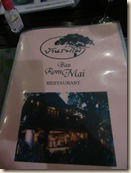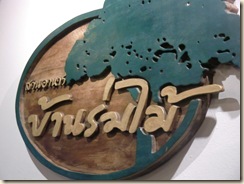Today we are taking our long bike ride out East of the city into the more rural and local areas. Our guide, Meou (think Meow), is waiting for us in the lobby when we arrive a little before 8:45. She already has the bikes outside and ready to go. Cool.

After we check out our rides, we head off on our adventure. We are supposed to be taking a join tour, so every time we come near another hotel (or just ride through the parking lot on our way out of the city), I think we’re going to stop and pick someone up – but not so. It’s ends up just the 3 of us – Ed, me and Meou. We are stoked! It will be great fun to make our own pace and do our own thing!
Meou takes us through little alley ways and lanes, through the aforementioned parking lots, across the iron bridge and deep into Chiang Mai suburbia. For the next hour or so, we cycle our way to the outskirts of the city – and it’s all way more urban than I would have expected. Commercial buildings, large roads, I think there are something like 3 ring roads (major highways)– a couple of which we have to cross to get out of town. And all the buildings are all jumbled together, new, old, small, large, poor, rich. Meou tells us this is the way it is, and that neighbors – even the rich and poor – all typically get along in these neighborhoods and look after each other. It’s just life here in this part of the city.
But, as we get further out, we start to see the development of luxury housing – where there used to be nothing but rice fields. Some of which are still standing, in between these housing areas, but others have been plowed under and filled to build upon.


We continue to cycle out into the country, passing active rice fields with the women working planting rice. They are doing it the old fashioned way, by hand, so they can ensure they get a good yield. Some farmers just throw the rice seed out into the fields, because it’s cheaper and less work intensive. But the random seeding doesn’t yield as much rice as the old fashioned hand planting.


After a while, we stop at a little market for some snacks and beverages. Then we make our way to a wat perched right on the rice fields for our mid-morning snack of rice crackers (really good Japanese snacks – we’re getting some at 7-11  when we get back!), sesame honey crackers, bananas and Cab Moo (fried pork skins – chicharrones for all you Spanish speakers!). It's so pretty and peaceful here – with cute little dogs who come to visit begging for a snack (which we are good and do not give!). The dogs are left here by people who can’t take care of them, knowing that the abbot and the monks will always feed them (and you can tell they are very well fed and good mannered too!).
when we get back!), sesame honey crackers, bananas and Cab Moo (fried pork skins – chicharrones for all you Spanish speakers!). It's so pretty and peaceful here – with cute little dogs who come to visit begging for a snack (which we are good and do not give!). The dogs are left here by people who can’t take care of them, knowing that the abbot and the monks will always feed them (and you can tell they are very well fed and good mannered too!).
Meou gives a quick history of the local wat – the abbot who runs the wat had some old antiques from his parents – things from when they were farming rice. He didn’t want to get rid of them, so he started a little museum of sorts. Then all the local people started bringing him things they didn’t want, and this museum just sort of grew and grew from donations. We tour it and there are tons and tons of great things in there like old paper money, old paper and palm fronds used for paper, radios, photos, household goods – there’s thousands of items placed all over what is probably a 1500 sq foot room. It was really amazing.

After our morning break, we cycle out into the wilderness, through little villages and lanes crisscrossing the rice fields. It’s a beautiful day and we just cycle along, listening to Meou’s great commentary on farm and local life.

It’s really wild the little villages we pass in the middle of nowhere – houses and maybe a market – then nothing. Then a little resort out in the valley – just a hodgepodge of stuff out here. Soon we are approaching the dam which is our furthest most destination. It’s the dam that the King thought up and the locals built to try to help alleviate flooding and regulate irrigation the area. The ensuing reservoir, Mae Kuang, is now a vast pristine lake used only for fishing and for tap water to be collected and sent down into the city. No swimming or personal use of the reservoir is allowed, because it is used for water. there are no houses or resorts up here, just a restaurant or two, but you can camp, the only restriction being you need to take out everything you bring in. A few pleasure boats are out on the water, but it is apparently tightly controlled as to use. We huff and puff our way up the hill to the Dam and then down to the water’s edge for a great seafood lunch at a little restaurant there.



After a lovely meal of fried fish, tom yum soup, stir fried veggies, fried rice and fried shrimps – we start our way back down from the reservoir. Stopping at one point for our picture with this sign that says “danger for tourists” (LOL – that was Meou’s translation!)

We cycle on, past sluiceways, and beautiful overlooks…
Even past a herd of water buffalo wandering down the road….
This is definitely country!
We go off road a bit, then end up back on paved roads, winding our way slowly back to town. A rest stop for more water gives us a breather and Meou extols us on the virtues of these little markets here on the sides of the road. They carry a little bit of everything because the farmers and locals use these places as their daily shopping stops. Usually only open it the afternoons, you’ll see a selection of fresh vegetables and fruit, as well as tiny, single sized packages of cleaning detergents, toiletries and other necessities. They are in small packages because these shoppers don’t have a set income and can’t be sure how much money they will bring in each month. So they buy what they can when they can – they can’t really stock up on big items, but manage their money almost daily to see what they can afford.
There is also a community/neighborhood type selling/buying, where locals come and either sell or trade their produce to the market owner (as we watch a woman is doing just that with her sweet potatoes). This helps everyone, and you know you are getting fresh food because it comes right out of someone’s garden. Small business socioeconomics at its best.
Our next and final stop of the day is at a rice “plant” where local farmers bring their rice to be processed. A local family runs it, and we get the 101 version of how rice is cracked, shelled and made ready to eat. The amazing thing is that you don’t have to pay for the rice processing if you only take the finished rice with you. If you leave the hulls and bi-products of the processing for the plant, the rice is free. If you want everything, then you have to pay. The rice plant makes its money by selling off the rice flour and straw and other bi-products you get when processing. Pretty wild!
We push on toward the hustle and bustle of the city. Finally stopping right outside one of the big new housing developments and picking up the truck to take us back into town (we had decided not to cycle into town in the evening because the traffic gets so crazy – we thought it would be safer in truck!). 60K total showing on Meou’s odometer. Wow!!! Long ride, but great day!
Back home – cooled and showered off – we head to the night market for food. End up at the “Thai” place (who knows the name? There are like 10 restaurants all jammed in together with banners that say Thai food, European Thai food…etc.) that has a sign for 39b pad thai. Really? $1.25? Ok, I’ll bite! And bite I did – huge portion of pad thai with fried tofu and chicken. Really great – the other food was great too. So, that made for a great ending to our athletic day!




















































